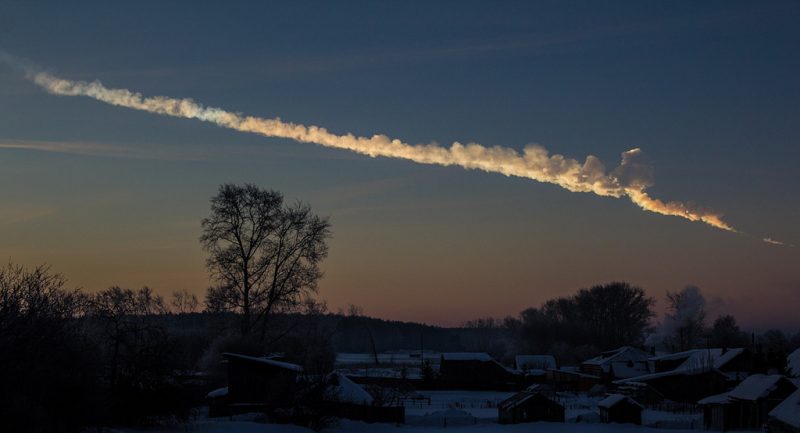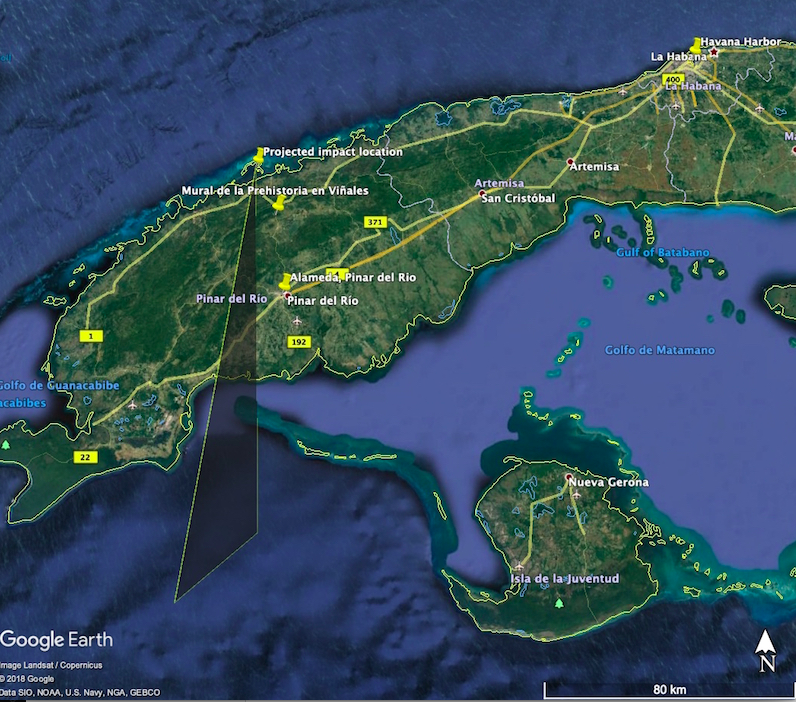
On February 1, 2019, a bright meteor crossed the sky over Cuba in the middle of the day. The phenomenon, followed by a smoke trail (a characteristic cloud left by a meteor burning up in the atmosphere) and a sonic boom, was witnessed by thousands of locals and tourists in the region of Pinar del Rio (western side of the island).
Almost at the same time of the impact, a cruise ship was leaving Havana Harbor and on board, Rachel Cook, an American tourist and vlogger, was making a timelapse of the undocking process. Without knowing it, she was recording one of the few videos known to date of the falling meteor. Meanwhile, about 250 miles (400 km) away, in Ft. Myers, Florida, a webcam of the EarthCam network was filming the midday activities on the beach. Luckily, the camera was aimed in the right direction to record the meteor.
Help EarthSky keep going! Please donate what you can to our once-yearly crowd-funding campaign.

Just a couple of minutes after the event, social networks, especially Instagram and Twitter, received a flood of dozens of videos and pictures taken from Cuba, most of them showing the smoke trail left by the meteor. One of those videos was particularly interesting. It was recorded in one of the main streets of the city of Pinar del Rio, and showed dozens of people in the street contemplating the remnant cloud in awe (see the video here). Although the video does not show the meteor, it was full of details about the place and time when it was recorded.

These events recalled the Chelyabinsk meteor of February 2013, when a super bolide, 400 times brighter than the Cuba meteor (according to NASA data released a few days after the Cuba impact), hit the atmosphere over a populated area in western Russia. The Chelyabinsk meteor was the first event of its kind witnessed by humans in almost a century.
Only a couple of days after the Chelyabinsk impact, a team of astronomers of the Institute of Physics of the University of Antioquia, led by Jorge I. Zuluaga, reconstructed the trajectory of the Chelyabinsk meteor exclusively using videos of the phenomenon published on YouTube.
Although many other teams in Russia, the Czech Republic, Canada and the U.S. also managed to reconstruct the trajectory using more sophisticated methods and data, the Colombian astronomers’ use of information available on the internet was well received. The study demonstrates the role that social networks and citizen science in general could have for investigating this type of phenomenon.
A week after the Cuba meteor event, and almost exactly six years after the February 15, 2013, Chelyabinsk impact, the same Colombian scientific team, again using information available on the internet, applied their methods to reconstruct the trajectory of the Cuban meteor. Their results are reported in a scientific paper. Read the preprint here. Zuluaga explained:
We were very lucky that at least three relatively reliable videos, including one of incredible quality, were available on the internet in such a short time. Reconstructing the trajectory of a meteor requires at least three observers on the ground. Although several satellite images were recorded and also available online, without observations from the ground a precise reconstruction is not feasible.
According to the reconstruction made by the Colombian astronomers, the object producing the meteor over Cuba started its trajectory inside the atmosphere at an altitude of about 47.5 miles (76.5 km) above the Caribbean Sea, over a point 16 miles (26 km) to the southwest of the San Felipe Keys (Cuba).
The speed of the rock at the time of its contact with the atmosphere was 11 miles (18 km) per second, or 40,260 miles (64,800 km) per hour. With such a velocity, the thin air of the high atmosphere was not enough to stop the object, although it was enough to heat it until the rock began to glow.
The meteor trajectory followed an almost straight line until it descended to an altitude of around 17 miles (27.5 km). It was at about that altitude that the smoke trail, observed by thousands in Cuba and visible in satellite images, started to develop. Zuluaga and co-authors estimate that the cloud seen in Pinar del Rio represents a small part of the trajectory of the meteor (corresponding to altitudes between 16 and 14 miles or 26 and 22.5 km). According to the footage from Pinar del Rio and the reconstruction of the Colombians, the airburst suddenly ended at about 13.7 miles (22 km) altitude.

From there on, hundreds of small fragments which survived the atmospheric ablation (friction) fell in many directions without emitting any light. Although most of these small rocks probably ended up in the forests of the Viñales Natural Park, some of them hit several houses in the Viñales Valley, close to a tourist landmark, El Mural de la Prehistoria, 3.7 miles (6 km) away from the main path of the object. If a big fragment survived the ablation, it probably landed in the ocean on the northwestern coast of the island.
After reconstructing the trajectory in the atmosphere, the Colombian astronomers “played back” the impact and found that the culprit, a rock with an estimated size of several meters and a weight of about 360 tons, came from an eccentric orbit around the sun with an average distance to our star of 1.3 astronomical units (one astronomical unit = about 93 million miles or 150 million km). Before impacting the Earth, the rock completed a turn around the sun every 1.32 years. All that came to an end on February 1, 2019, when both the rock and the Earth found themselves at the same point in space at the same time. All the worse for the rock!
Bottom line: A team of astronomers used YouTube videos to determine the trajectories of the 2013 Chelyabinsk meteor and the bright meteor that crossed the sky over Cuba on February 1, 2019.
Source: Can we predict the impact conditions of meter-sized meteoroids?
Via the Solar, Earth and Planetary Physics Group at the University of Antioquia, Medellin, Colombia











